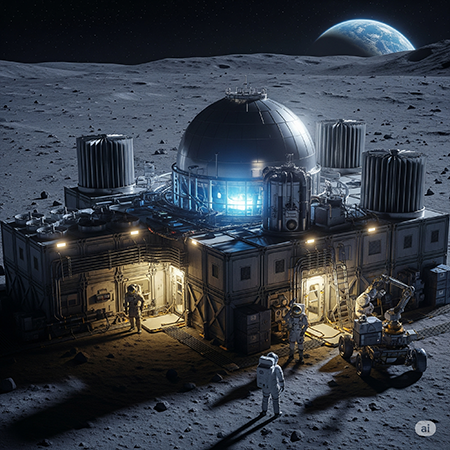In recent years, discussions about placing a nuclear power reactor on the Moon have intensified, fueled by the renewed global interest in space exploration. As space agencies like NASA and private companies such as SpaceX push toward establishing long-term human presence on the lunar surface, one key issue emerges: How will future lunar missions be powered efficiently and sustainably?

This essay explores whether building a nuclear reactor on the Moon is possible, who would be held accountable for any potential dangers, the environmental consequences, and the reasoning behind choosing the Moon for such an endeavor. It also addresses some surprising questions, including whether a lunar nuclear facility could somehow cause a tsunami on Earth.
Is It Possible to Build a Nuclear Reactor on the Moon?
Can a nuclear power plant be built on the moon ??
Yes, it is scientifically and technically possible to build a nuclear reactor on the Moon—though not without significant challenges. In fact, NASA has already awarded contracts to companies like Lockheed Martin and Westinghouse to develop small nuclear fission systems for lunar use by the early 2030s.
The Moon lacks atmosphere, has extreme temperature swings, and undergoes long periods of darkness—up to 14 Earth days at a time—making solar power unreliable for continuous energy. That’s where small modular nuclear reactors designed for space environments become the most viable power option for lunar bases.
Why Put a Nuclear Reactor on the Moon?
Long-tail keyword: reasons for using nuclear energy on the moon
The primary reason for using nuclear power on the Moon is energy reliability. Unlike solar panels that depend on daylight, nuclear energy can deliver constant power regardless of lunar conditions. This is essential for:
- Running life support systems
- Conducting scientific experiments
- Powering communication systems
- Supporting future lunar mining and manufacturing
In addition, the Moon may serve as a launch pad for deeper space exploration. Establishing reliable energy infrastructure there could enable missions to Mars and beyond.
Who Is Responsible for the Negative Effects?
Who is accountable for nuclear energy accidents in space ?
One of the most critical concerns with lunar nuclear reactors is accountability. Currently, international space law—primarily the Outer Space Treaty of 1967—dictates that the country or organization launching a space mission bears full responsibility for any damage caused by their equipment or actions, including nuclear-powered systems.
This means if a nuclear reactor launch fails and crashes back to Earth, the launching nation or company is liable. However, there are gaps in enforcement and accountability when it comes to long-term effects on the Moon’s environment or broader cosmic safety concerns.
What Are the Possible Dangers and Environmental Effects?
Risks of nuclear reactor in outer space :
While the Moon itself has no atmosphere or life, the risks of a nuclear reactor in space are still considerable:
- Launch accidents involving radioactive material
- Space debris collisions with reactors
- Radiation leakage that could affect future lunar missions
- Ethical concerns around space contamination
Although the Moon is lifeless, mistakes in its nuclear handling could set dangerous precedents for off-world energy development. Critics argue that placing reactors on the Moon might open the door to militarization of space under the guise of energy exploration.
Could a Nuclear Reactor on the Moon Cause a Tsunami on Earth?
Can space activity cause natural disasters on Earth?
No, a nuclear reactor on the Moon cannot cause a tsunami on Earth. Tsunamis are triggered by seismic activity—like undersea earthquakes or volcanic eruptions—not by anything happening on the Moon, which is 384,400 kilometers away.
Even in a worst-case scenario where a nuclear accident occurred on the Moon, the energy output would be confined to the lunar surface. Earth’s tides are affected by the Moon’s gravitational pull, but radioactive emissions or explosions on the Moon would not impact Earth’s oceans.
What About Public Opinion and Ethics?
Public concerns about space nuclear energy ?
Many people express concerns about nuclear energy in space, especially given humanity’s track record with nuclear disasters on Earth (like Chernobyl or Fukushima). While space nuclear reactors differ significantly in size and design from terrestrial ones, the word “nuclear” still triggers anxiety.
Ethical debates focus on questions like:
- Should we place nuclear reactors in environments we haven’t fully explored?
- Are we potentially polluting space before we even colonize it?
- What international agreements need to be in place before large-scale deployment?
Conclusion: Is a Lunar Nuclear Reactor the Future of Space Exploration?
Building a nuclear reactor on the Moon is not only possible, it is already underway in design and testing phases. While the technical feasibility is becoming clearer, the ethical, legal, and environmental questions remain open.
To move forward safely, global cooperation, transparency, and updated international space laws on nuclear energy are essential. With the right frameworks, nuclear power could revolutionize lunar exploration—powering not just machines, but a new era of interplanetary civilization.